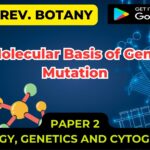CYTOGENETICS OF ANEUPLOIDS AND STRUCTURAL HETEROZYGOTES
- The expression and inheritance of the sum total of characters of an organism is determined by the number and sequence of genes of its cells.
- Most of the plant and animal species are diploid and in their somatic tissue chromosomes are found in pairs.
- The number of chromosomes in a species normally remains constant through successive generations and their results into the constancy of characters.
- Gametes produced as a result of meiosis possess half as many chromosomes as the somatic cells and in them each chromosome is represented only once.
- Fusion of gametes brings together homologous chromosomes from the two parents and restores the diploid number.
- Alternation of haploid and diploid generations occurs in all sexual organisms.
- There is a great diversity in the number of chromosomes in different species.
- But this number is fixed in a particular species.
- Chromosome number is one of the characters that differentiate one species from another.
- In plants the somatic chromosome number ranges from four (two pairs) in Haplopappus to as many as 1260 in Ophioglossum.
- Constancy of the genetic material through successive generations is essential for maintaining the identity of a species.
- But variation is necessary if evolution has to occur. Sometimes such variations involve whole chromosome or chromosome sets and can be seen cytologically.
Variations that involve changes in number are of two types –
Euploidy– variations that involve entire sets of chromosome and,
Aneuploidy-variations that involve only single chromosome of a set.
Numerical changes in chromosomes or variations in chromosome number means heteroploidy can be mainly of two types namely
(i)Aneuploidy (ii) Euploidy
Aneuploidy- means presence of chromosome number which is different than a multiple of basic chromosome number, or variants that involve one or only a few chromosomes but not the entire set.
Euploidy– on the other hand, means presence of chromosome number which is similar multiple of basic chromosome number, or variation involve in entire sets of chromosomes.
- In above both alteration in chromosomes number, addition (hyperpoidy) or loss of chromosomes, entire set or individually (hypoploidy) present.
Fig 4.1A diagrammatic representation of different types of numerical changes given below
Fig 4.1A
(x = basic chromosome number, 2n = somatic chromosome number, n = chromosome number of a gamete)













